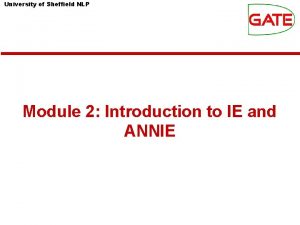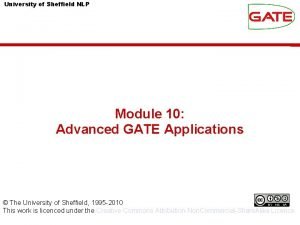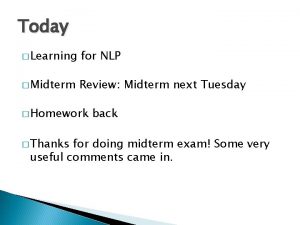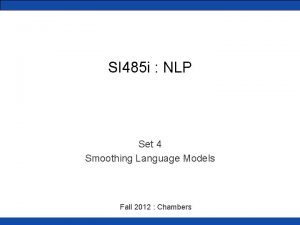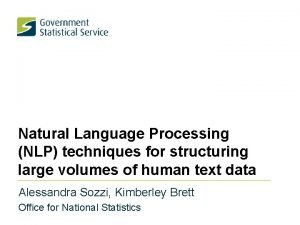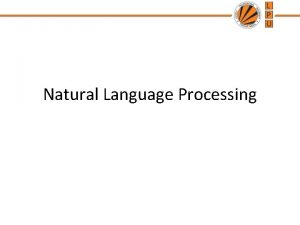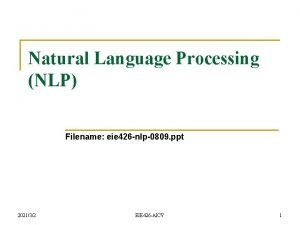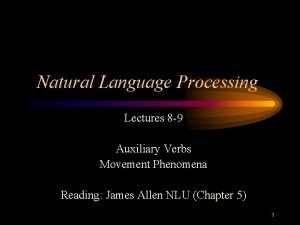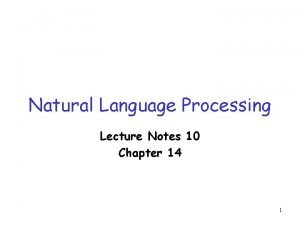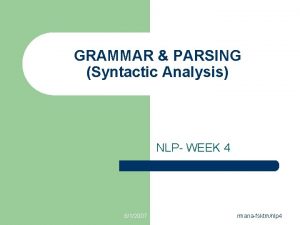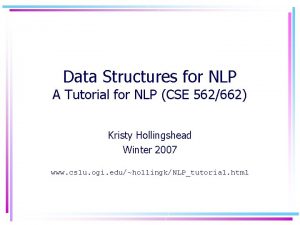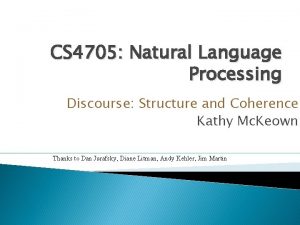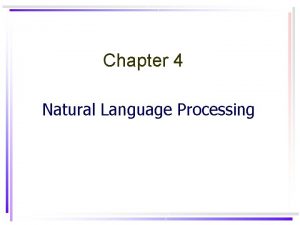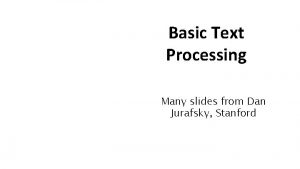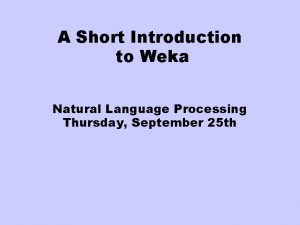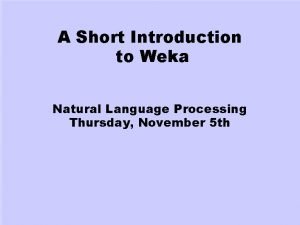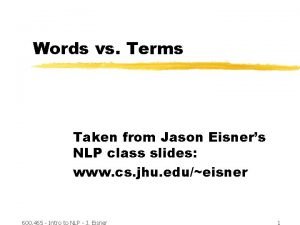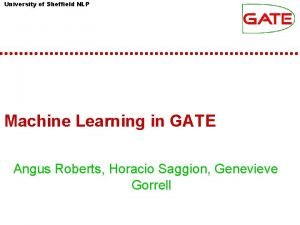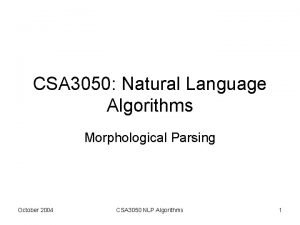fast NLP fast NLP fast NLP fast Data














![在fast. NLP中用Bert做文本分��共需要几步 ? data_bundle = IMDBLoader(). process(‘imdb/’) bert_embed = Bert. Embedding(data_bundle. vocabs['words'], model_dir_or_name='en-base') model 在fast. NLP中用Bert做文本分��共需要几步 ? data_bundle = IMDBLoader(). process(‘imdb/’) bert_embed = Bert. Embedding(data_bundle. vocabs['words'], model_dir_or_name='en-base') model](https://slidetodoc.com/presentation_image_h2/16c29658c3f44765c9dd1722a8a276d0/image-15.jpg)

















![在fast. NLP中用做中文序列�注�共需要几步 ? data_bundle = Chinese. NERLoader(). process('MSRA-NER/') char_embed = Static. Embedding(data_bundle. vocabs['chars'], model_dir_or_name='cn-char') 在fast. NLP中用做中文序列�注�共需要几步 ? data_bundle = Chinese. NERLoader(). process('MSRA-NER/') char_embed = Static. Embedding(data_bundle. vocabs['chars'], model_dir_or_name='cn-char')](https://slidetodoc.com/presentation_image_h2/16c29658c3f44765c9dd1722a8a276d0/image-33.jpg)

![Text Preprocess Index Embed Encode Decode Train def generate_bigram(instance): chars = instance['chars'] next_chars = Text Preprocess Index Embed Encode Decode Train def generate_bigram(instance): chars = instance['chars'] next_chars =](https://slidetodoc.com/presentation_image_h2/16c29658c3f44765c9dd1722a8a276d0/image-35.jpg)










- Slides: 45



fast. NLP�什么




fast. NLP是什么

fast. NLP是什么? fast是什么? 数据 Data. Set 模型 Model �失函数与�价指 � Loss, Metric �化算法 Optimizer 参数学� Trainer

fast. NLP是什么 SGD Adam. W Ada. Grad Cross-entropy NLL. . Accuracy Span. F 1 Rouge … Optimizer Loss Metric Data. Set. Iter Data Tester Trainer Sampler Biaffine Star-Trans Text. CNN … Model Data. Loader Random. Sampler Data. Set Bucket. Sampler Vocabulary … … Embedding Encoder Decoder GLOVE ELMO BERT … LSTM Transformer CNN … CRF MLP …



文本分� 数据(情感分� ): Aggressive self-glorification and a manipulative whitewash. negative Best indie of the year , so far. positive It 's everything you 'd expect -- but nothing more. neutral


Bi. LSTM+MLP 模型�构 : he W 1 h 1 likes W 2 h 2 label size it W 3 h 3 . W 4 h 4 input embedding Bi. LSTM pooling Encoder module MLP decoder module label output
![在fast NLP中用Bert做文本分共需要几步 databundle IMDBLoader processimdb bertembed Bert Embeddingdatabundle vocabswords modeldirornameenbase model 在fast. NLP中用Bert做文本分��共需要几步 ? data_bundle = IMDBLoader(). process(‘imdb/’) bert_embed = Bert. Embedding(data_bundle. vocabs['words'], model_dir_or_name='en-base') model](https://slidetodoc.com/presentation_image_h2/16c29658c3f44765c9dd1722a8a276d0/image-15.jpg)
在fast. NLP中用Bert做文本分��共需要几步 ? data_bundle = IMDBLoader(). process(‘imdb/’) bert_embed = Bert. Embedding(data_bundle. vocabs['words'], model_dir_or_name='en-base') model = Bi. LSTMMLP(bert_embed, len(data_bundle. vocabs[‘target’])) Trainer(data_bundle. datasets[‘train’], model, loss=Cross. Entropy. Loss(), device=0, batch_size=32, dev_data=data_bundle. datasets['dev‘], metrics=Accuracy. Metric()). train() 只比把大象装�冰箱 多一步

Text Preprocess Index Embed Encode Decode Train fast. NLP. core. Data. Set 示例(情感分� ): Aggressive self-glorification and a manipulative whitewash. negative Best indie of the year , so far. positive It 's everything you 'd expect -- but nothing more. neutral instance 1 raw_words 1 target 1 instance 2 raw_words 2 target 2 … … …. . 人�在理解数据�, 一般是通�一个一个 的sample去理解,即 通�行的方式 批�理更喜�以 列的方式�行� 取与�理 Batch 1

Text Preprocess Index Embed Encode Decode Train fast. NLP. core. Data. Set Field 1 Field 2 …… Instance …… …… Data. Set以列作�存�方式

Text Preprocess Index Embed Encode Decode Train fast. NLP. core. Data. Set 示例(情感分� ): Aggressive self-glorification and a manipulative whitewash. negative dataset = Data. Set() with open('train. txt', 'r') as f: for line in f: if line: parts = line. strip(). split('t') dataset. append(Instance(raw_words=parts[0], target=parts[1])) # 以行��位�取 # �理�以列��位 dataset. raw_words. split() # 将�一列的每一行内容按空格切分成独立的 word print(dataset[0]) �出 { 'raw_words': ['Aggressive', 'self-glorification', 'and', 'a', 'manipulative', 'whitewash', '. ’] type=list, 'target': negative type=str }

Text Preprocess Index Embed Encode fast. NLP. core. Vocabulary 当前的Data. Set raw_words target [‘Aggressive’, ‘self-glorification’, ‘and’, ‘a’, ‘manipulative’, ‘whitewash’, ’. ’] ‘negative’ [‘Best’, ‘indie’, ‘of’, ‘the’, ’year’] ‘positive’ … … 神�网�需要的 Data. Set(需要index) words target [2, 100, 245, 3, 50, 30, 10] 1 [3, 6, 101, 8, 19] 4 … … 使用Vocabulary来�� Decode Train

Text Preprocess Index Embed Encode Decode Train fast. NLP. core. Vocabulary 当前的Data. Set raw_words target [‘Aggressive’, ‘self-glorification’, ‘and’, ‘a’, ‘manipulative’, ‘whitewash’, ’. ’] ‘negative’ [‘Best’, ‘indie’, ‘of’, ‘the’, ’year’] ‘positive’ … … vocab = Vocabulary(). from_dataset(dataset, field_name='raw_words') vocab. index_dataset(dataset, field_name='raw_words', new_field_name='words') �理后的 Data. Set raw_words target [‘Aggressive’, ‘self-glorification’, ‘and’, ‘a’, ‘manipulative’, ‘whitewash’, ’. ’] [2, 100, 245, 3, 50, 30, 10] ‘negative’ [‘Best’, ‘indie’, ‘of’, ‘the’, ’year’] [3, 6, 101, 8, 19] ‘positive’ … …

fast. NLP. core. Data. Set. Iter 在�行 mini-batch-SGD的�候,每次取出 batch_size的数据,并做padding dataset. set_input('words') dataset. set_target('target’) for batch_x, batch_y in Data. Set. Iter(dataset, batch_size=32, num_workers=1, as_numpy=True): """ batch_x: {"words": (batch_size, max_len)的矩� } batch_y: {"target": (batch_size, )的向量} """ # 可以是pytorch的迭代或者tensorflow的迭代

Text Preprocess Index Embed Encode Decode Train �建模型 �� ���的 Embedding glove word 2 vec Char. Embedding ELMO Bert 50 d 100 d cnn small base 100 d 200 d lstm meidium large 300 d transformer large wwm … … … ��太多,且 Embedding之� tokenize的方式有很大差异 glove_embed = Static. Embedding(vocab, model_dir_or_name='en-glove-6 b-50’) glove_embed = Static. Embedding(vocab, model_dir_or_name='en-glove-840 b-300') word 2 vec_embed = Static. Embedding(vocab, model_dir_or_name='en-word 2 vec-300') tencent_embed = Static. Embedding(vocab, model_dir_or_name='cn-tencent')

Text Preprocess Index Embed Encode Decode Train �建模型 # 同�使用两种 embedding embed = Stack. Embedding([glove_embed, word 2 vec_embed]) # 使用character embedding和word embedding一�容易 char_embed = CNNChar. Embedding(vocab) embed = Stack. Embedding([char_embed, glove_embed]) Contextual Embedding: 一行代�切� ELMO,BERT elmo_embed = Elmo. Embedding(vocab, model_dir_or_name='en-original') bert_embed = Bert. Embedding(vocab, model_dir_or_name='en-base’) embed = Stack. Embedding([glove_embed, elmo_embed, bert_embed]) �里的 Embedding和pytorch的Embedding是一�,所以可以与其它 pytorch代�混合 使用,也可以�独 使用�里的 Embedding

Text Preprocess Index Embed Encode Decode Train �建模型 class Bi. LSTMMLP(nn. Module): def __init__(self, init_embed, num_classes, hidden_dim=256, num_layers=1, nfc=128): super(Bi. LSTMSentiment, self). __init__() self. embed = init_embed self. lstm = LSTM(input_size=self. embedding_dim, hidden_size=hidden_dim, num_layers=num_layers, bidirectional=True) self. mlp = MLP(size_layer=[hidden_dim* 2, nfc, num_classes]) fast. NLP的embedding def forward(self, words): 与pytorch的module可 x_emb = self. embed(words) output, _ = self. lstm(x_emb) 以直接嵌入使用 output = self. mlp(torch. max(output, dim=1)[0]) return {C. OUTPUT: output} model = Bi. LSTMMLP(glove_embed, 3) model = Bi. LSTMMLP(elmo_embed, 3) # 使用elmo model = Bi. LSTMMLP(bert_embed, 3) # 使用Bert model = Bi. LSTMMLP(stack_embed, 3) # 使用多种embedding

Text Preprocess Index Embed Encode Decode Train Loss, Metric与Optimizer loss = Cross. Entropy. Loss() metric = Accuracy. Metric() optimizer = Adam(model. parameters(), lr=2 e-3) 参数学� trainer = Trainer(dataset, model, batch_size=32, loss=loss, metrics=metric, optimizer=optimizer) trainer. train()

Text Preprocess Index Embed Encode Decode Train fast. NLP. core. callback ���程中可能需要加入一些 trick,比如learning rate warm-up, gradient clipping, 或者tensorboard�����程等。 on_train_begin() on_epoch_begin() on_batch_begin() callback可以通�����的方法 来在���程中某个�点做相� 的操作。 ���程是可以定制化的。 on_loss_begin() on_backward_end() on_batch_end() on_valid_begin() on_valid_end() on_epoch_end() on_train_end()

Text Preprocess Index Embed Encode Decode Train fas. NLP. core. callback 代�示例 : gradient_clip = Gradient. Clip. Callback(clip_value = 5) # 梯度裁剪 lr_warmup = Warmup. Callback(warmup=0. 1) # 学�率的 warmup callbacks = [gradient_clip, lr_warmup] trainer = Trainer(dataset, model, batch_size=32, loss=loss, metrics=metric, optimizer=optimizer, callbacks=callbacks) trainer. train()

Text Preprocess Index Embed Encode Decode Train 所有代� dataset = Data. Set() with open('. . /test. txt', 'r') as f: for line in f: if line: parts = line. strip(). split('t') dataset. append(Instance(raw_words=parts[0], target=parts[1])) dataset. raw_words. split() dataset. set_input('words') dataset. set_target('target’) model = Model(stack_embed, 3) # 使用多种embedding vocab = Vocabulary(). from_dataset(dataset, field_name='raw_words') vocab. index_dataset(dataset, field_name='raw_words', new_field_name='words') loss = Cross. Entropy. Loss() metric = Accuracy. Metric() optimizer = Adam(model. parameters(), lr=2 e-3) target_vocab = Vocabulary(padding=None, unknown=None). from_dataset( dataset, field_name='target') vocab. index_dataset(dataset, field_name='target', new_field_name='target’) gradient_clip = Gradient. Clip. Callback(clip_value = 5) # 梯度裁剪 lr_warmup = Warmup. Callback(warmup=0. 1) # 学�率的 warmup callbacks = [gradient_clip, lr_warmup] glove_embed = Static. Embedding(vocab, model_dir_or_name='en-glove-6 b-50') elmo_embed = Elmo. Embedding(vocab, model_dir_or_name='en-original') stack_embed = Stack. Embedding([glove_embed, elmo_embed]) trainer = Trainer(dataset, model, batch_size=32, loss=loss, metrics=metric, optimizer=optimizer, callbacks=callbacks) trainer. train() class Bi. LSTMMLP(nn. Module): def __init__(self, init_embed, num_classes, hidden_dim=256, num_layers=1, nfc=128): super(Bi. LSTMSentiment, self). __init__() self. embed = init_embed self. lstm = LSTM(input_size=self. embedding_dim, bidirectional=True, hidden_size=hidden_dim, num_layers=num_layers, ) self. mlp = MLP(size_layer=[hidden_dim* 2, nfc, num_classes]) def forward(self, words): x_emb = self. embed(words) output, _ = self. lstm(x_emb) output = self. mlp(torch. max(output, dim=1)[0]) return {C. OUTPUT: output}




Bi. LSTM+CRF 模型�构 : 复 W 1 h 1 label 旦 W 2 h 2 label 大 W 3 h 3 label 学 W 4 h 4 label input embedding encoder module Bi. LSTM CRF decoder module
![在fast NLP中用做中文序列注共需要几步 databundle Chinese NERLoader processMSRANER charembed Static Embeddingdatabundle vocabschars modeldirornamecnchar 在fast. NLP中用做中文序列�注�共需要几步 ? data_bundle = Chinese. NERLoader(). process('MSRA-NER/') char_embed = Static. Embedding(data_bundle. vocabs['chars'], model_dir_or_name='cn-char')](https://slidetodoc.com/presentation_image_h2/16c29658c3f44765c9dd1722a8a276d0/image-33.jpg)
在fast. NLP中用做中文序列�注�共需要几步 ? data_bundle = Chinese. NERLoader(). process('MSRA-NER/') char_embed = Static. Embedding(data_bundle. vocabs['chars'], model_dir_or_name='cn-char') bi_embed = Static. Embedding(data_bundle. vocabs['bigrams'], model_dir_or_name='cn-bigram') model = CNBi. LSTMCRFNER(char_embed, num_classes=len(data_bundle. vocabs['target']), bigram_embed= bi_embed) Trainer(data_bundle. datasets['train'], model, loss=None, batch_size=32, metrics=Span. FPre. Rec. Metric(data_bundle. vocabs['target'], encoding_type='bioes'), num_workers=1, dev_data=data_bundle. datasets['dev'], device=0). train()

![Text Preprocess Index Embed Encode Decode Train def generatebigraminstance chars instancechars nextchars Text Preprocess Index Embed Encode Decode Train def generate_bigram(instance): chars = instance['chars'] next_chars =](https://slidetodoc.com/presentation_image_h2/16c29658c3f44765c9dd1722a8a276d0/image-35.jpg)
Text Preprocess Index Embed Encode Decode Train def generate_bigram(instance): chars = instance['chars'] next_chars = chars[1: ] + ['<eos>'] bigrams = [c 1+c 2 for c 1, c 2 in zip(chars, next_chars)] return bigrams for dataset in [train, dev]: # 将tag从BIO�型�� BIOES dataset. apply_field(lambda tags: iob 2 bioes(tags), field_name='target’, new_field_name='target') # 增加一个bigram dataset. apply(generate_bigram, new_field_name='bigrams') # 增加一列表示序列的�度 dataset. add_seq_len('chars') chars target bigrams seq_len ['中', '共', '中', '央', '致', '中', ' 国', '致', '公', '党', ‘十‘, …] ['B-ORG', ‘I-ORG', 'I-ORG', ‘EORG', 'O', 'B-ORG', . . . ] [‘中共’, ‘共中’, ‘中央’, ‘央致’, ‘ 致中’, ‘中国', ‘国致', …] 40 [‘在’, ‘� ’, ‘去’, ‘的’, ‘五’, ‘年’, ‘ 中’, ‘,’, ‘致‘, . . . ] [‘O’, ‘O’, ‘B-ORG’, ‘I-ORG‘, …] [‘在� ’, ‘�去 ’, ‘去的’, ‘的五’, ‘ 五年’, ‘年中’, ‘中,’, . . . ] 23 … …

Text Preprocess Index Embed Encode Decode Train # 建立�表,�� index vocabs = {} for field_name in [‘chars’, ‘bigrams’]: vocabs[field_name] = Vocabulary(). from_dataset(train, field_name=field_name) vocabs[field_name]. index_dataset(train, dev, field_name=field_name) target_vocab = Vocabulary(padding=None, unknown=None). from_dataset(train, field_name='target') target_vocab. index_dataset(train, field_name='target’) Index之后的Data. Set chars target bigrams seq_len [9, 226, 9, 467, 518, 9, 5, 518, 75, 167, 179, 6, 15, …] [4, 1, 1, 5, 0, 4, 1, 1, 1, 5, 0, 0, 0, …] [1026, 1735, 93, 64482, 88303, 3, 30021, 12881, …] 40 [0, 0, 4, 1, 5, 0, 8, 7, 9, …] [0, 0, 4, 1, 5, 0, 8, 7, 9, 0, …] [6183, 653, 3059, 6868, 4826, 2695, 47, 4621, 12881, . . ] 23 … …

Text Preprocess Index Embed Encode Decode Train # 随机初始化两个embedding char_embed = Static. Embedding(char_vocab, model_dir_or_name='cn-char') bigram_embed = Static. Embedding(bigram_vocab, model_dir_or_name=‘cn-bigram') # �建模型, Bi. LSTM+CRF class CNBi. LSTMCRFNER(nn. Module): def __init__(self, char_embed, bigram_embed, tag_vocab , encoding_type='bioes'): super(). __init__() self. char_embed = char_embed self. bigram_embed = bigram_embed self. lstm = LSTM(self. char_embed_dim+self. bigram_embed_dim, 50, num_layers=1, bidirectional=True, batch_first=True) self. fc = nn. Linear(100, len(tag_vocab)) allowed_trans = allowed_transitions(tag_vocab. idx 2 word, encoding_type= encoding_type, include_start_end=True) self. crf = Conditional. Random. Field(len(tag_vocab), include_start_end_trans=True, allowed_transitions=allowed_trans)

Text Preprocess Index Embed Encode Decode def forward(self, chars, bigrams, seq_len, target=None): chars = self. char_embed(chars) bigrams = self. bigram_embed(bigrams) chars = torch. cat((chars, bigrams), dim=-1) feats, _ = self. lstm(chars, seq_len) logits = F. log_softmax(self. fc(feats), dim=-1) mask = seq_len_to_mask(seq_len) if target is None: pred, _ = self. crf. viterbi_decode(logits, mask) return {‘pred’: pred} else: loss = self. crf(logits, target, mask). mean() return {'loss': loss} model = CNBi. LSTMCRFNER(char_embed, bigram_embed, target_vocab) Train

Text Preprocess Index Embed Encode Decode Train # �置�入与目� train. set_input('chars', 'bigrams', 'seq_len', 'target') dev. set_input('chars', 'bigrams', 'seq_len') dev. set_target('target') trainer = Trainer(train, model, batch_size=32, dev_data=dev, sampler= Bucket. Sampler(), metrics=Span. FPre. Rec. Metric(target_vocab, encoding_type='bioes')) trainer. train()

Data. Set. Loader conll 2003 Onte. Notes NER ��多种任�的数据��理。 MSRA-NER SNLI 从Data. Set. Loader中�取�入的数 据即可�行��和��。 data_bundle = Conll 2003 Data. Loader(). process('c onll 2003/') print(data_bundle) Conll 2003: In total 3 datasets: train has 14041 instances. dev has 3250 instances. test has 3453 instances. In total 2 vocabs: words has 30291 entries. target has 17 entries. MNLI RTE Matching QNLI Quora Yelp_p Yelp_f Text classification sst-2 IMDB CNN/Daily. Mail Newsroom Summarization The New York Times Annotated Corpus DUC …

Model char_cnn Elmo NER Bert 提供多种模型的��参考。 以上的模型,我�都会尽力�� 到�文所�道的 performance。 ESIM CNTN DIIN Matching Mw. AN … char_cnn dpcnn Text classification HAN … LEAD 3 ORACLE Summarization BERTSUM … …

�什么 fast. NLP



 Differentiate between acid fast and non acid fast bacteria
Differentiate between acid fast and non acid fast bacteria Acid fast and non acid fast bacteria
Acid fast and non acid fast bacteria Fast data cover
Fast data cover Fast data analysis
Fast data analysis Sheffield nlp
Sheffield nlp Annie nlp
Annie nlp Gate nlp
Gate nlp Nlp midterm exam
Nlp midterm exam Statistical natural language processing
Statistical natural language processing Smoothing nlp
Smoothing nlp Nlp syntax
Nlp syntax Nlp search engine
Nlp search engine Classic parses
Classic parses Self-attention
Self-attention What is nlp techniques
What is nlp techniques Discourse integration in nlp
Discourse integration in nlp Discourse integration in nlp
Discourse integration in nlp Auxiliary verb in nlp
Auxiliary verb in nlp Fopc in nlp
Fopc in nlp Natural language processing
Natural language processing Markov chain nlp
Markov chain nlp Nlp for education
Nlp for education Reference phenomenon in nlp
Reference phenomenon in nlp Reference phenomena in nlp
Reference phenomena in nlp Coherence and cohesion
Coherence and cohesion Needleman wunsch
Needleman wunsch Instance weighting for domain adaptation in nlp
Instance weighting for domain adaptation in nlp Nlp syntactic analysis
Nlp syntactic analysis Buy nlu
Buy nlu Node nlp tutorial
Node nlp tutorial Dan jurafsky nlp slides
Dan jurafsky nlp slides What is discourse in nlp
What is discourse in nlp Discourse integration in nlp
Discourse integration in nlp Dan jurafsky nlp slides
Dan jurafsky nlp slides Weka nlp
Weka nlp Weka nlp
Weka nlp Elmo nlp
Elmo nlp Information retrieval nlp
Information retrieval nlp Sheffield nlp
Sheffield nlp Context reframe
Context reframe Nlp master
Nlp master Collocation meaning
Collocation meaning Nlp training thailand
Nlp training thailand Nlp lecture notes
Nlp lecture notes What is morphology in nlp
What is morphology in nlp Morphological parsing in nlp
Morphological parsing in nlp





